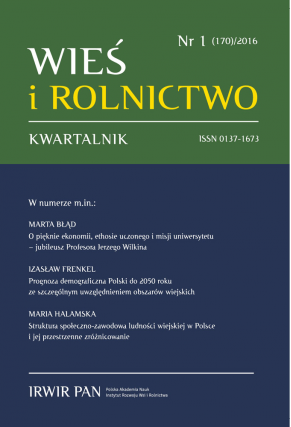Functional Changes and Conversion of Agricultural Land in the Area with Fragmented Agrarian Structure
DOI:
https://doi.org/10.53098/wir012016/09Keywords:
conversion of agricultural land, multifunctional development, local land-use plans, sub-regional city, Tarnow countyAbstract
Abstract: The following study aims at verifying whether and to which extent functional changes affect the conversion of agricultural land. The land under study features fragmented agrarian structure and the proximity of a subregional city with a population of more than 100 thousand. The paper describes legal conditions of agricultural land conversion (AL), analyses the risk of conversion and the functional and spatial changes of the area under study in 2004–2013. High population density and fragmented agrarian structure create strong pressure on AL conversion. The data illustrating changes in the income structure of agricultural holdings show that the area becomes multifunctional. A simultaneous analysis of utilized agricultural area supported by direct payment shows no relevant change in the share of AL. This leads to a conclusion that the functional transformation does not necessarily mean corresponding spatial changes. They may be based on a more intensive use of land which has already been urbanized. This way of thinking is absent among local land-use planners. In 2011–2013 the surface of non-agricultural land in local land-use plans has increased several times.References
Agencja Restrukturyzacji i Modernizacji Rolnictwa, dane uzyskane na wniosek o ponowne wykorzystanie informacji publicznej, 27.05.2015.
Anusz S. (red.) (2008). Planowanie przestrzenne w Polsce po wprowadzeniu ustroju samorządowego – diagnoza stanu i nowe propozycje. Warszawa: Instytut Gospodarki Przestrzennej i Mieszkalnictwa.
AzadiH., Ho P., Hasfiati L. (2010). Agricultural land conversion drivers: a comparison between less developed, developing and developed countries. Land Degradation and Development. DOI: https://doi.org/10.1002/ldr.1037
Bank Danych Lokalnych, Główny Urząd Statystyczny.
Czarnecki A. (2009). Rola urbanizacji w wielofunkcyjnym rozwoju obszarów wiejskich. Warszawa: Instytut Rozwoju Wsi i Rolnictwa PAN.
European Environment Agency (2006). Urban Sprawl in Europe. The Ignored Challenge. Luxembourg: Office for Official Publications of the European Communities.
Farmland Abandonment 2013. Assessing the risk of farmland abandonment in the EU. Join Research Center. Institute for Environment and Sustainability.
Felcenloben D. (2009). Wyłączenie gruntów z produkcji rolnej w kontekście aktualizacji ewidencji gruntów i budynków. Samorząd Terytorialny, 4, 61–68.
Fogel P. (2012). Wskaźniki oceny polityki i gospodarki przestrzennej w gminach. Biuletyn KPZK, 250.
Harvey M., Pilgrim S. (2011). The new competition for land: Food, energy, and climate change. Food Policy, 36, 40–51. DOI: https://doi.org/10.1016/j.foodpol.2010.11.009
Informacje o dokonanych transakcjach w zakresie nieruchomości gruntowych w powiecie tarnowskim w całym 2013 r. Urząd Statystyczny w Krakowie.
Koncepcja Przestrzennego Zagospodarowania Kraju 2030 (2012). Monitor Polski, poz. 252.
Kowalewski A., Mordasewicz J., Osiatyński J., Regulski J., Stępień J., Śleszyński P. (2014). Ekonomiczne straty i społeczne koszty niekontrolowanej urbanizacji w Polsce – wybrane fragmenty raportu. Samorząd Terytorialny, 4, 5–21.
Li X., Gar-On Yeh A. (2004). Analyzing spatial restructuring of land use patterns in a fast growing region using remote sensing and GIS. Landscape and Urban Planning, 69, 335–354. DOI: https://doi.org/10.1016/j.landurbplan.2003.10.033
Majchrzak A. (2015). Ziemia rolnicza w krajach Unii Europejskiej w warunkach ewolucji wspólnej polityki rolnej. Warszawa: Wydawnictwo Naukowe PWN.
Mazzocchi Ch., Sali G., Corsi S. (2013). Land use conversion in metropolitan areas and the permanence of agriculture: Sensitivity Index of Agricultural Land (SIAL), a tool for territorial analysis. Land Use Policy, 35, 155–162. DOI: https://doi.org/10.1016/j.landusepol.2013.05.019
Musiał W. (2008). Ekonomiczne i społeczne problemy rozwoju obszarów wiejskich Karpat Polskich. Warszawa: Instytut Rozwoju Wsi i Rolnictwa PAN.
Obrót Nieruchomościami w 2013 roku, Główny Urząd Statystyczny.
Pérez-Soba M., Danes M., Van Eupen M., Hazeu G. (2013). Applying the Land Use Functions framework for spatial assessment of land multifunctionality and impacts of land use change on land performance and efficiency. W: Bański J., Garcia-Blan co G. (red.). European Land Use Patterns (s. 119–167). Warszawa: Komisja Obszarów Wiejskich Polskie Towarzystwo Geograficzne, Instytut Geografii i Przestrzennego Zagospodarowania im. Stanisława Leszczyckiego PAN.
Plantinga A., Miller D. (2001). Agricultural land values and the value of rights to future land development. Land Economics, 77 (1), 56–67. DOI: https://doi.org/10.2307/3146980
PSR (2002, 2010). Powszechny Spis Rolny. Warszawa: Główny Urząd Statystyczny.
Rasmussen R.O., Weber R. (2013). Analysis of land use and land use change dynamics in the EU-LUPA project. W: Bański J., Garcia-Blanco G. (red.). European Land Use Patterns (s. 21–61). Warszawa: Komisja Obszarów Wiejskich Polskie Towarzystwo Geograficzne, Instytut Geografii i Przestrzennego Zagospodarowania im. Stanisława Leszczyckiego PAN.
Stanny M. (2013). Przestrzenne zróżnicowanie rozwoju obszarów wiejskich w Polsce. Warszawa: Instytut Rozwoju Wsi i Rolnictwa PAN.
Starostwo Powiatowe w Tarnowie, dane uzyskane na wniosek o ponowne wykorzystanie informacji publicznej, 16.12.2014.
Śleszyński P., Komornicki T., Deręgowska A., Zielińska B. (2015). Analiza stanu i uwarunkowań prac planistycznych w gminach w 2013 roku. Warszawa: Instytut Geografii i Przestrzennego Zagospodarowania PAN na zlecenie Ministerstwa Infrastruktury i Rozwoju.
Środowisko Europy 2015. Stan i Prognozy. Europejska Agencja Środowiska.
Tavares A.O., Monteiro M., Vargas M.A., Pato R.L., Serra R. (2014). Land use change and forest routing in a rural context: The relevance of the community-based management and planning framework. Applied Geography, 52, 153–171. DOI: https://doi.org/10.1016/j.apgeog.2014.05.008
Ustawa o ochronie gruntów rolnych i leśnych z dnia 3 lutego 1995 r. (tekst jedn. Dz.U. 2015, poz. 909).
Ustawa o planowaniu i zagospodarowaniu przestrzennym z dnia 27 marca 2003 r. (tekst jedn. Dz.U. 2015, poz. 199 ze zm.).
Wilkin J. (2010). Wielofunkcyjność rolnictwa. Kierunki badań, podstawy metodologiczne i implikacje praktyczne. Warszawa: Instytut Rozwoju Wsi i Rolnictwa PAN.
Wojewodzic T. (2014). Dezagraryzacja produkcyjno-ekonomiczna gospodarstw rolnych w Polsce – próba pomiaru zjawiska. J. Agribus. Rural Dev., 4 (34), 213–223.
Downloads
Article file downloads
Pages
How to Cite
Issue
Section
License
Copyright (c) 2016 Wieś i Rolnictwo

This work is licensed under a Creative Commons Attribution 4.0 International License.










